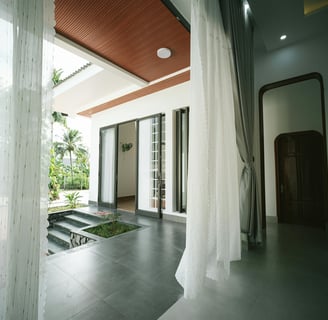Outdoor-Indoor Fusion: Blurring the Lines Between Nature and Home
Embrace biophilic design with earthy textures, large windows, and seamless indoor-outdoor living.
Dreamy Decor | Steph B
4/12/20252 min read


The connection between our living spaces and the natural world has never been more essential. As we seek calm, comfort, and balance at home, biophilic design—a concept rooted in bringing nature indoors—has become a major trend in modern interiors. Through thoughtful choices in materials, layout, and decor, it’s easier than ever to blur the lines between the outdoors and your everyday living spaces.
Whether you live in an apartment, a suburban home, or a rural retreat, you can embrace outdoor-indoor fusion to create a more grounded, restorative environment. Here’s how to invite the beauty of nature into your home with style and intention.
1. Emphasize Natural Light
Maximizing natural light is the first step in creating a seamless connection between indoor and outdoor environments.
Ideas to Try:
Use large, unobstructed windows or sliding glass doors to open up views
Replace heavy drapes with sheer curtains or linen panels
Incorporate mirrors to reflect natural light deeper into your space
Tip: Even in smaller homes, consider swapping a solid door for one with glass panels to let the outside in.
2. Bring in Earthy, Organic Textures
From floors to textiles, using organic materials creates a tactile connection to nature.
Ideas to Try:
Use jute, rattan, wood, and stone in furniture and decor
Layer woven rugs, linen drapes, and cotton throws
Choose natural finishes like matte ceramics, raw woods, and clay-based paints
Tip: Opt for imperfections—like knotted wood or handmade ceramics—that celebrate the beauty of the natural world.
3. Create Indoor Greenery Moments
Plants are a core element of biophilic design, offering both aesthetic appeal and wellness benefits.
Ideas to Try:
Arrange clusters of houseplants like ferns, snake plants, or pothos
Use hanging planters or vertical gardens to save space
Grow herbs in sunny windows for both style and function
Tip: Vary plant height and container texture to add interest and dimension.
4. Extend Living Spaces Outdoors
Make your outdoor areas feel like a natural extension of your home.
Ideas to Try:
Furnish patios or balconies with cushioned seating and outdoor rugs
Install string lights or lanterns for evening ambiance
Use folding doors or wide windows to connect interior and exterior areas
Tip: Match color palettes and materials between indoor and outdoor zones to create cohesion.
5. Add Water and Nature-Inspired Features
Subtle nods to nature can reinforce a sense of serenity throughout your space.
Ideas to Try:
Use tabletop fountains or wall-mounted water features for a soothing soundscape
Incorporate landscape-inspired artwork or nature-themed wallpaper
Choose decor in leaf, stone, or botanical motifs
Tip: Small touches like pebbles in bowls or driftwood sculptures bring quiet outdoor energy indoors.
6. Focus on Flow and Open Layouts
A fluid layout enhances the feeling of movement and openness in your home.
Ideas to Try:
Keep sightlines open by minimizing bulky furniture and walls
Use wide doorways or archways to invite natural movement between spaces
Incorporate low-profile furniture to maintain visual flow
Tip: Layer with floor cushions, poufs, or benches to create flexible seating zones.
Final Thoughts
Outdoor-indoor fusion is more than a design trend—it’s a way to live more mindfully and intentionally. By integrating nature into your home through light, texture, greenery, and layout, you can create a peaceful sanctuary that supports well-being year-round.
